Contents
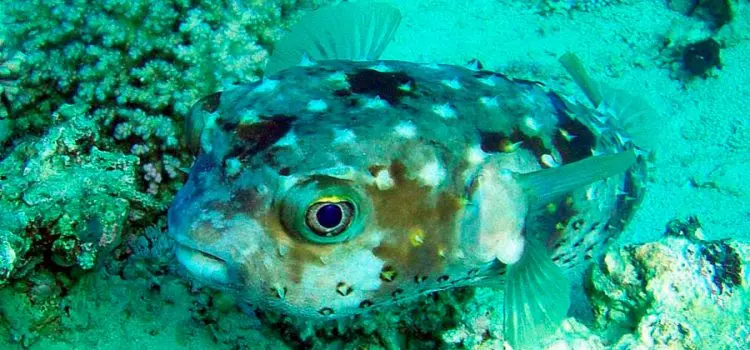
Puffer fish or takifugu (Takifugu) is a rather interesting and unique representative of ray-finned fish, which belongs to the family of pufferfish and to the order of pufferfish. The takifugu fish species consists of several dozen subspecies, 2 of which are on the verge of extinction.
Fugu fish: description
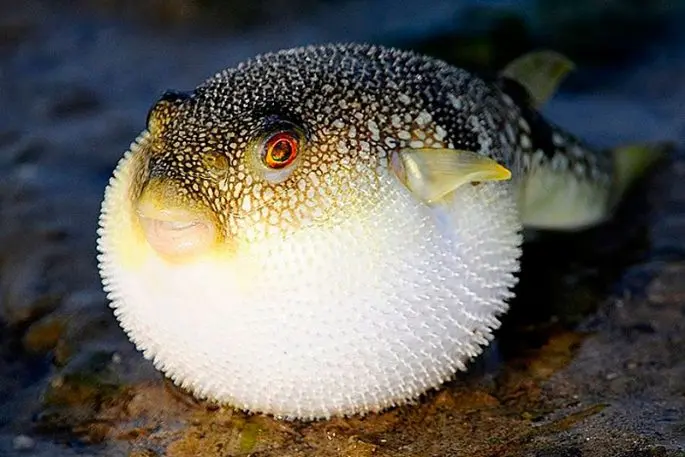
Poisonous representatives of the pufferfish family differ in that they have other names. For example:
- Skalozubye, in which the teeth have grown together and represent a monolithic structure.
- Four-toothed or four-toothed, in which the teeth on the jaws are fused and form two upper and two lower plates.
- Dog fish, which have a well-developed sense of smell, and they are able to detect odors in the water column at a considerable distance.
For the Japanese, takifugu fish occupies a certain place in Japanese culture, and in Eastern culture in general. The poison of the fish acts on living beings, leading to paralysis of the muscles. At the same time, the living being retains the purity of consciousness until the moment of death. Death occurs as a result of suffocation. Today, there is no antidote to the poison of puffer fish, so doctors, in case of poisoning, simply support the functioning of the human respiratory and circulatory system until the poison completely stops.
Interesting fact! A feature of the pufferfish is the fact that they do not have scales, and the body is protected by elastic and dense skin.
Appearance, dimensions
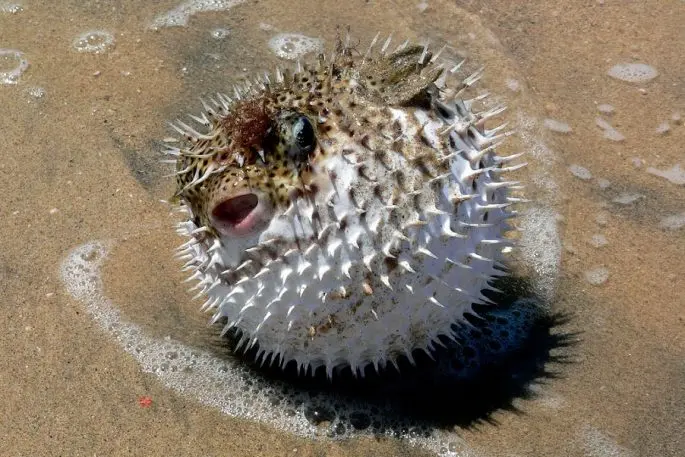
Most Takifugu species inhabit the Pacific Northwest. Some species are found in freshwater rivers in China. The genus is distinguished by the fact that all its representatives are omnivores, they have fairly strong teeth, the dimensions of which often go beyond the reasonable. This is due to the fact that in the diet of these fish there are no abrasive components. In case of danger, poisonous fish can easily bite the object of danger.
Most species of takifugu have not yet been studied to a significant extent, although there is a lot of data in relation to the species “Brown puffer”. This is due to the fact that this species is of commercial interest and is bred artificially, as it is actively used in cooking. The period of his life is different in that the “brown puffer” constantly changes its color from darker to lighter shades. As a rule, this factor depends on the characteristics of the habitat.
Fugu fish can grow up to 85 cm in length, but mostly there are individuals that do not exceed half a meter in length. On the sides, immediately behind the pectoral fins, there is one large spot surrounded by a white ring. Peculiar spines grow on the surface of the body. The jaw teeth, located in a small mouth, are fused together and represent two plates that resemble a parrot’s beak.
The dorsal fin of the fish is formed from 2 dozen rays, and in the anal fin there are about one and a half dozen of them. The ovaries and liver are considered the most toxic in fish, while the intestines of fugu fish are less toxic, but in meat, in the skin and in the testes, although there is poison, it is not in dangerous concentrations. Fish do not have gill covers. In front of the pectoral fin, you can see a small hole that is connected to the gills and directed inside the body.
Interesting to know! The species “Brown puffer” is an object for research, so scientists are conducting various biological experiments.
Lifestyle, behavior
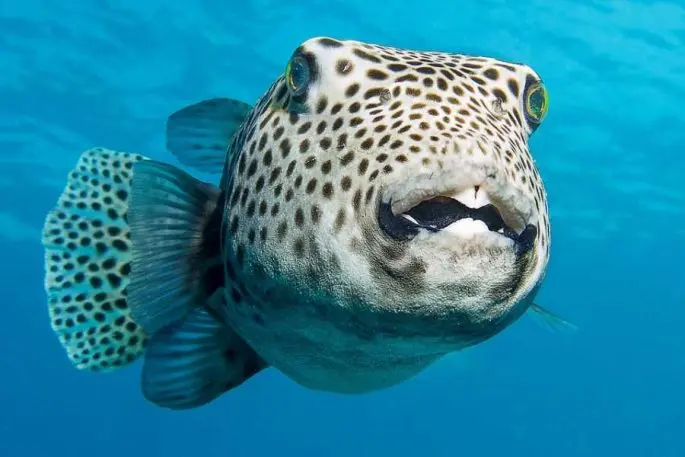
Pufferfish cannot move in the water column at high speed, as this does not allow for a body shape that does not have special aerodynamic characteristics. Despite this fact, the puffer fish has excellent maneuverability. It can move forward, backward and even sideways. Therefore, the fish perfectly maneuvers, moving away from its natural enemies, which it practically does not have.
The fish has a pear-shaped body, so it rarely spends time in the water column, preferring to stay in the bottom area. At the same time, the fish chooses areas with a complex bottom topography, where oysters live and a lot of grass cover. It is often found in numerous flocks in the shallow, sandy waters that are characteristic of estuaries or channels, as well as areas of water located near reefs or near abundant aquatic vegetation.
Fugue fish are quite curious and active. At the same time, it can show hostility towards other inhabitants of the underwater world, as well as towards its relatives. When the fish is in danger, it inflates the same and takes the form of a ball. This is due to the presence of a special valve located at the bottom of the mouth.
It is important to know! The eyes of the fish are relatively small, but its vision does not suffer from this. There are a large number of receptors on the tentacles located in the eye area, which allows the fish not only to see perfectly in the water column, but also to have other abilities.
How long does puffer fish live
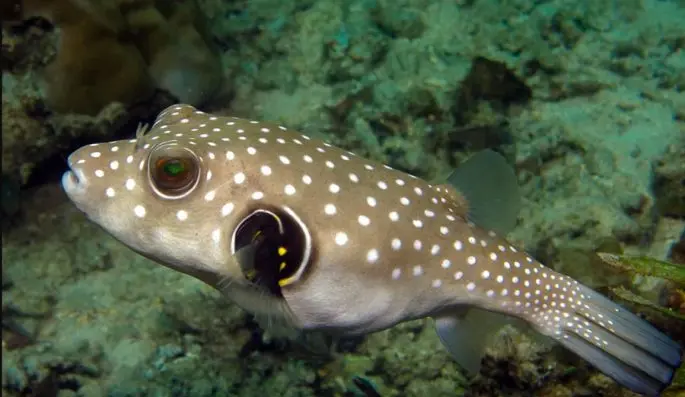
Types of fish “Brown puffer” do not differ in longevity, as they can live no more than 12 years. It is believed that other representatives of the Takifugu species do not live longer.
Fugu fish poison
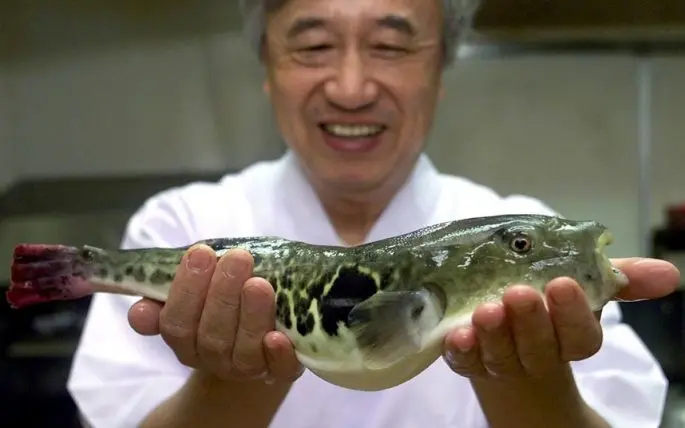
Dishes from this fish are not only dangerous to health, but also quite expensive. Moreover, the more toxic the meat, the more money restaurant customers agree to pay. One carcass of medium-sized fish can cost about $ 300, and the cost of a set lunch is somewhere around $ 1000, or even more. The toxicity of the fish lies in the fact that its tissues contain the poison tetrodoxin, and there is so much of it in the fish that at least 30 people can be poisoned. It is believed that the poison tetrodoxin is much more toxic than poisons such as strychnine, cocaine or curare poison.
Already 15 minutes after eating toxic puffer fish, the first symptoms of poisoning begin to appear. First of all, the lips and tongue lose sensitivity, after which there is a strong salivation and impaired coordination of movements. More than half of those who are poisoned leave for another world already on the first day, so the day is considered a critical period for a person. Often, negative symptoms are accompanied by diarrhea and vomiting, as well as severe pain in the abdominal cavity. At the same time, different types of fugu differ in different degrees of toxicity.
Features of tetrodoxin are that it prevents the passage of nerve impulses by blocking the passage of sodium ions through cell membranes, while the active components of the poison do not adversely affect potassium ions. As a rule, toxic components in pufferfish are concentrated in the skin. Based on this information, when toxins interact with cellular structures, pharmacists are considering using the poison as a pain reliever, of course, in very small doses.
Despite the fact that puffer fish is poisonous and, all the more expensive, its popularity does not suffer from this, but vice versa. The high cost of puffer fish dishes lies in the fact that cooking requires high professionalism, since everyone who wants to can not do this. In specialized restaurants, this fish is cut and prepared exclusively by licensed chefs. They professionally extract the insides, although a clean fillet contains some concentration of toxins. This concentration of poison is capable of causing symptoms of poisoning, but cannot lead to death. Although it is possible that the Japanese managed to develop immunity to this poison, as they have been eating dishes from puffer fish for several centuries. Evidence of this is the fact when two Russian tourists died in a restaurant after eating dishes from this fish.
Interesting fact! After eating even properly cooked fish, restaurant visitors feel a state of mild drug intoxication, with numbness of the palate, tongue and limbs, against the backdrop of a feeling of mild euphoria.
Range, habitats
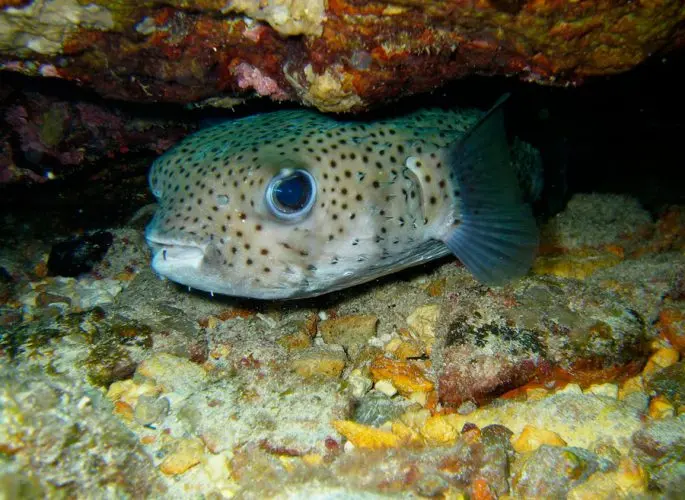
The main populations of puffer fish live in the sea waters of the northwestern Pacific Ocean. In addition, its habitat is extended to the southern waters of the Sea of Okhotsk, to the western waters of the Sea of Japan, where it is concentrated not far from the mainland, up to Olga Bay. Pufferfish are also caught in the Yellow and East China Seas, in close proximity to the Pacific coast of Japan, from Kyushu to Volcano Bay.
The fish also enters the northern waters of Peter the Great Bay, as well as the waters of the Sea of Japan, which border Russia. During the summer, fugu in these waters is considered a common representative of the underwater world. At the same time, the fish prefers to be at depths of up to 100 meters. Adults often appear in bays, and also enter estuaries where the water is not as salty. Fry and juvenile fugu are quite common in such areas, but, having reached a certain age, they try to go to the open sea, away from the coastline.
Interesting to know! Fugu fish also inhabits fresh water bodies, such as the Nile River, the Niger River, the Congo River, the Amazon River, including Lake Chad.
Diet
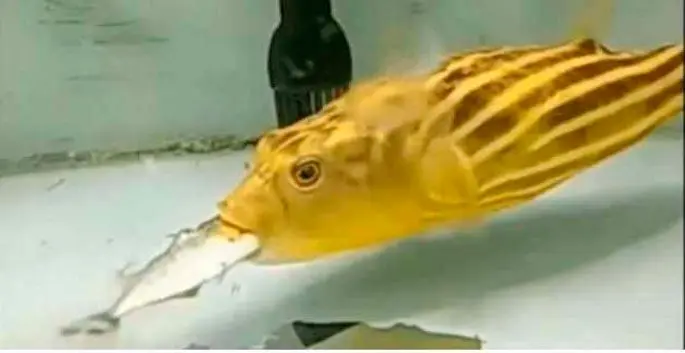
Puffer fish feed on living organisms that it finds at the bottom of the seas and oceans. Her diet includes fairly large starfish, sea urchins, all kinds of molluscs, worms, algae, and corals.
Many scientists around the world are sure that puffer fish is so poisonous because it has a special diet. Since some fish food items contain toxic components, they accumulate in the flesh of the fish, as well as in internal organs such as the stomach, intestines, liver, etc., while fish roe is also poisonous. The fish itself does not feel any discomfort from the fact that such a level of toxins is in its body.
When the fish is kept in artificially created conditions (for example, in an aquarium), then they are offered ordinary (classic) food as food, as for ordinary aquarium fish. As a rule, these are bloodworms, worms, molluscs, all kinds of crustaceans, tubules, etc. For fry, fish serve as food for smaller organisms, in the form of ciliates, cyclops, daphnia, crushed egg yolk, etc.
Interesting information! Scientists in the Japanese city of Nagasaki have developed a special, non-poisonous type of puffer fish. The species is different in that it still accumulates toxins in the body, but only in the process of growth and development, and not from birth.
Reproduction and offspring

The spawning process of puffer fish begins in March and continues until the end of the spring months. The fish is also interesting in that it approaches the process of the birth of future offspring with all responsibility, and this especially applies to males. Before the onset of the spawning period, the males begin to care for the females, describing circles around them. If a sexually mature female accepts the male’s courtship, then she begins to sink to the bottom, where they begin to search for a suitable stone to lay eggs.
When a stone is selected, the female lays eggs on it, and the male immediately fertilizes it. As a rule, females immediately leave the spawning grounds, while males remain. Being constantly on a stone, they protect their future offspring with their bodies. Therefore, eating caviar by other fish species is absolutely excluded. After the birth of offspring, the male makes a small depression in the bottom. In this recess, the fry are until they begin to feed on their own. Throughout this period, the male guards his offspring.
Fugu’s natural enemies
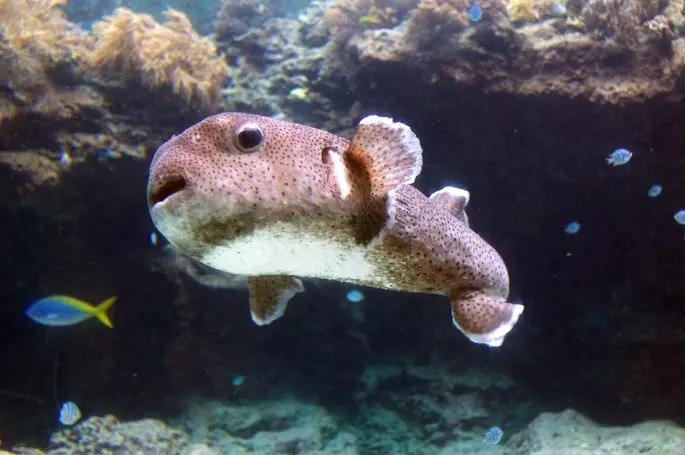
Oddly enough, but most representatives of the underwater world know that puffer fish are poisonous, including notorious predators. Therefore, next to this fish, it is unlikely that it will be possible to observe the vital activity of other species of fish. In case of danger, the puffer fish puffs up and becomes like a prickly ball, and its meat is so toxic that even predators try to bypass it.
Fishing value

This fish is bred in some Asian countries on specialized farms. As a rule, artificially grown fish is not as expensive as wild-caught fish. This is due to the fact that supporters of Japanese traditions prefer fish caught on the high seas or in the ocean. This fact is due to the fact that many chefs of the highest qualification have spent a lot of money, time and effort to obtain a special permit for the right to cook dishes from this fish – a license.
This fish is easy to catch in a natural reservoir if you use tackle such as a regular float rod, a regular throw or a spinning rod, with various types of lures. Moreover, fishing is associated with some riddles, since the fish does not swallow the hook, but clings to it mainly with its belly. Often at one time it is possible to pull out several fish.
In 1958, Japan passed a law requiring chefs to have a special license. To obtain such a permit, a person must pass 2 exams: theory and practice. Many applicants cannot pass the first stage, where they must demonstrate knowledge of the presentation of various species of puffer fish, as well as talk about methods for detoxifying fish. At the second stage, the cook must prepare one of the dishes and eat it himself.
Dishes prepared from puffer fish are served according to a certain ritual: first, the client is served pieces from the back of the fish, which are characterized by minimal toxicity, and at the end of the ritual, pieces from the belly, in which the maximum concentration of poison. At the same time, the chef is obliged to monitor the health of the client in order to provide professional assistance in a timely manner. This is necessary in order to minimize any negative effects associated with eating pufferfish meat.
A unique drink is prepared from the fins of fugu fish, which acts on the body like a light drug. As a result of its use, the work of the sense organs is stimulated, a hallucinogenic effect appears, as well as a feeling of slight intoxication. To prepare a drink, it is enough to place slightly charred fins in sake for one minute. A similar exotic drink is offered to customers to drink before real puffer fish dishes are served.
Interesting fact! In 1975, a fatality was reported when the legendary actor Mitsugoro Bando participated in a puffer fish liver tasting. It happened in a restaurant in the city of Kyoto, then the actor died of extensive paralysis.
Population and species status
Currently, most of the species that belong to the genus “Takifugu” are not threatened, with the exception of two species such as “Takifugu chinensis” and “Takifugu peagiocellatus”.
What else is known about puffer fish
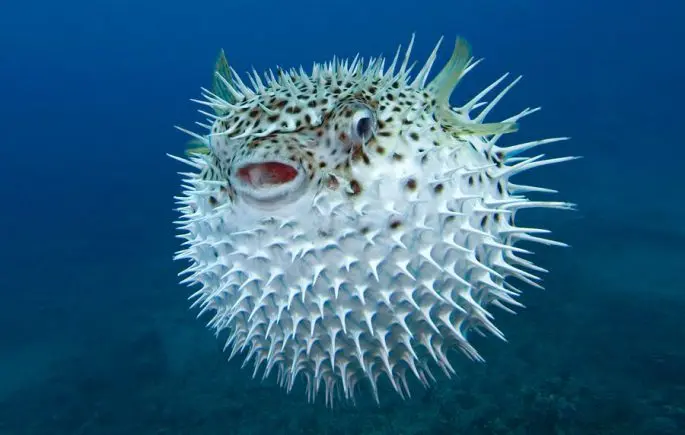
Fugu fish is an integral part of the culture of the Land of the Rising Sun. This is evidenced by a monument to this fish, installed in one of the parks in Tokyo. In one of the temples located near the city of Osaka, you can see a tombstone carved in honor of this fish. Representatives of this genus are used to make lamps and candlesticks in small workshops, and they also make kites.
And yet, the main meeting of man and this fish takes place in specialized restaurants. At the same time, it should be noted that up to 20 people die every year in Japan, who decided to cook puffer fish dishes on their own. Most likely, they did not cope with their task and could not properly butcher the fish. After all, if you touch the insides of a fish with your bare hand, you can die right there. The poison tetrodoxin is 1200 times more toxic than the well-known potassium cyanide. 1 mg of this poison is enough for a person to die, and there is no antidote for it to this day. Fugu fish is used in various dishes, including soups and sauces.
The most famous dish is fugusashi. The basis of the dish is mother-of-pearl pieces of raw fish, which are laid out on a round dish in the form of petals, creating various visual pictures, which testifies to the high professionalism of the chefs. Pieces of fish are eaten by dipping them in various sauces beforehand. The task of the chef is not only to serve the dish to the customers in a certain order, but also to monitor the physical condition, which depends on many factors that are known only to the chefs.
Kitaoji Rosannin, a master maker of unique ceramics, wrote: “The taste of this fish is incomparable. If you eat fugu three or four times, you will become a fugu slave.” This is also due to the fact that the use of fugu is accompanied by the manifestation of a narcotic effect. Gourmets who managed to try dishes from this fish note that as they eat the dish, a paralyzing wave appears, which starts from the legs, then passes to the hands, after which the jaw is immobilized. This effect appears for some moments, after which the gift of speech returns and the legs and arms begin to work.
Most likely, such sensations make people take mortal risks, as well as the unique, delicate taste of fish, incomparable to anything else. What is most interesting, the more toxic the fish, the more money clients are willing to pay for this risk. As a rule, the most toxic puffer fish occurs in the spring.
Artificially grown puffer fish is not as popular, as it does not have such unique qualities, and the profit from it is not so significant for restaurants. In addition, chefs of such high qualification do not want to spend time preparing dishes from cheap fugu.
Poisonous Fugu fish migrated to the Crimea









